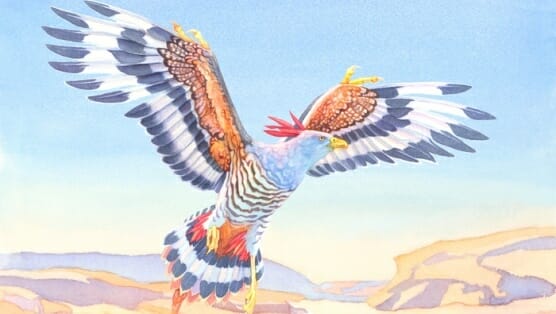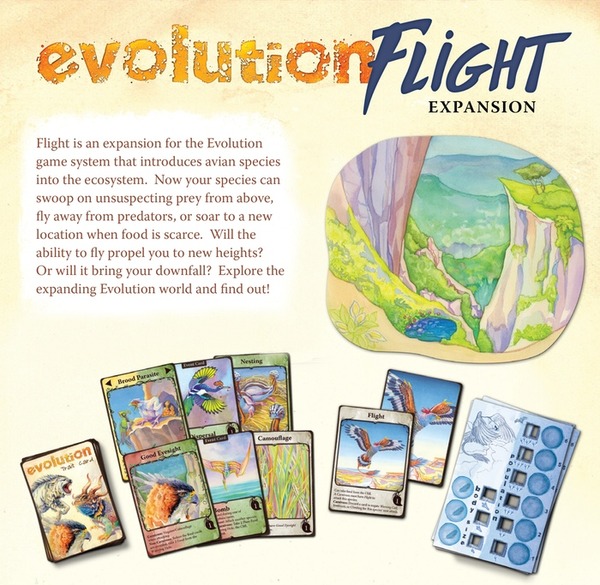
Evolution was one of my top ten games of 2014, a successful Kickstarter endeavor that takes one of my favorite topics in science and converts it into a clever game of competition among species, with the players starting up species and fighting over a limited food supply. Yet on further plays, I’ve found that the game’s core Carnivore mechanic isn’t that well balanced into the overall game, a problem that affects the new Flight expansion as well.
I reviewed the first edition of Evolution last winter, and the second edition incorporates only minor changes with updated graphics and rotating species boards for play on smaller tables. Each player begins the game with a single species, represented by a board that has tracks for population and body size, and may add more species and/or modify existing ones with Trait cards. Some of those cards allow the affected species to grab food from the central supply more efficiently, while others turn plant-eaters into carnivores, with the remaining Trait cards revolving around the battle between carnivorous species and the remaining herbivores. A Carnivore can’t eat plant food from the watering hole, which is available to all players, and must attack other species; there are Trait cards that allow other players to defend their species against Carnivores, and yet more Trait cards that allow Carnivores to penetrate certain defenses.
On each turn, players may discard Trait cards to add new species, grow an existing species’ population level (one per card), or grow existing species’ body size (the same). A player can also play a Trait card to a specific species to modify it, with each player placing new Trait cards face-down, up to three per species at any given time, until they’re all revealed simultaneously before the feeding phase of each round. In the feeding phase, each player takes one food from the central watering hole to feed an herbivore, or attacks another species to feed a carnivore (reducing the victimized species’ population by one), and must supply each species with food up to its population level or else reduce that species’ population at the end of the round. If a species’ population drops to zero, that species goes extinct and is removed from the board. At the end of each round, players remove all of their consumed food to their bags for tallying at game-end; players receive one point per food token consumed, one per population of extant species, and one per active Trait card on those species.
The Flight expansion adds a new Trait card that’s separate from the main deck, the Flight card, with its own type of species board. While regular species can grow their body sizes from 1 (where they start) to six, flying species can only grow up to size 3, but must first consume enough food to match their body size on each turn before they can start to feed their population, with the food taken for the body size food track going back to the food bank rather than to the player’s bag for scoring. Flying species can only add two Traits, as one of their trait spots is taken up by the Flight card itself, but have natural protection from predators as they can only be attacked by another flying species. Flying species also have access to the Cliff, a second supply of plant food that regular species can’t touch; the presence of two supplies means players with flying species need to pay more attention to which species they feed first and which supply they use.
However, across multiple plays, I’ve found that utilizing Carnivores is too difficult to incorporate smoothly into an overall strategy, and Flight has similar problems: the hurdles to make those species successful are very high. It’s too easy for a player to defend his species against Carnivores because of the variety of traits that either deter attacks (Horns, which causes the Carnivore to lose one population for a successful attack) or preclude it if the attacked lacks the one specific Trait that overcomes it. Without Carnivores in the game, however, it’s just a race among the plant-eaters to grab as much food as possible with each stab at the watering hole, with many species going extinct at the end of the game when the demand for plant food outstrips the supply. That leads to an hour that can be as frustrating as it is enjoyable, and one that doesn’t benefit enough from the added complexity of the Carnivore and Flight cards.
Keith Law is a senior baseball writer for ESPN.com and an analyst on ESPN’s Baseball Tonight. You can read his baseball content at search.espn.go.com/keith-law and his personal blog the dish, covering games, literature, and more, at meadowparty.com/blog.
